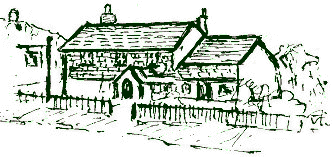The History of Forest Green
Geographical position
This is the story of Forest Green, a hamlet whose origin is vague, but whose charm is in its siting, almost equidistant from Dorking, Guildford and Horsham. The expansive common-land is sheltered on the north by the greensand ridge, running from east to west, with Leith Hill as the apex and Holmbury Hill slightly lower. Early settlers on these hills were known to be Saxon, but the weald was sparsely populated, as deep clay and streams from the hillside rendered it impassible in the winter, while the hard-baked soil of summer was not conductive to settlement.
The Domesday Book
There is mention in Domesday Book of a Manor, Hoclei, which may have been Gosterwood. Certainly the Manor of Gosterwood is of very early derivation. Following the Normal Conquest and deed without date, a Daniel de Gostrode granted to Maurice de Gostrode and his wife Maud, all his heritage of Gostrode.
The Evelyn Family
When the name changed from Gostrode to Gosterwood seems uncertain, it was probably a gradual emergence over the centuries. It was part of the Manor of Wotton rather than a separate manor in its own right. From 1444 until 1593, families named Bardsey, Wyatt and Hill owned the Manor, then described as a "moated Grange." In 1593, Richard Hill conveyed to George Evelyn Esq., from whom it descended with the Evelyn Wotton Estate until it was sold by the Evelyns in two parts, the first including the house in about 1922, the second, comprising the fields on the east side and the wood in 1972.
The advent of the Evelyn family was significant: by the end of the 16th Century, George Evelyn was established on the north side of Leith Hill at Wotton House. The Evelyn Estate, still a major land owner today, was formed in 1579, and by 1625 included Forest Green. His son, John Evelyn, the diarist (1620-1706) and his descendants, thus had tenure over all the properties from 1629, be they manor, farm or small dwelling, about 7,000 acres in all.
The Emergence of Forest Green
William Cobbett must have passed through Forest Green. In his well-known book, "Rural Rides," is an entry for August 8, 1926. "At Ewhurst, which is a very pretty village - I treated my horse to some oats and myself to a rasher of bacon. I had now to come round among the lanes at a couple of miles distanced from the foot of Leith Hill, in order to get to Ockley. From Ewhurst the first three miles was the deepest clay that I ever saw. I was warned of the difficulty of getting along, but was not to be frightened at the sound of clay - It took me, however, a good hour and a half to get along these three miles. Now, mind, this is a real weald, where the clay is bottomless. - At Ockley, I passed the house of a Mr. Steer [Jayes Park], who has a great quantity of hay-land, which is very pretty."
The emergence of Forest Green as an entity appears in 1580, when a record refers to "Folles Green," and later in the same document to "Forest," the modern spelling. Intervening years show Forrest in 1738, back in 1807 as Folles, while scattered about is "Farleyes," "Ferless," and "Farleys Green." Spelling, a controversial matter in modern times, was easy and adaptable and euphonious names could be bandied about. About the middle of the last century the spelling "Forest Green" seems to have been settled. It is interesting to note that there are countless "Greens" and "Forests" in England, and many around Surrey, but there is only one Forest Green.
Buildings and Inn from 15th Century onwards
There is no indication of the hamlet on an old Robert Morley map, circa 1598, although Ewhurst and Okeley, now Ockley, are shown. Between these two villages, approximately seven miles apart, the Oke Brook is shown clearly, rising as several springs on Holmbury Hill and near High Ashes Farm on Leith Hill. It meanders its way down through Forest Green gardens, under small bridges, and, at one time, worked the Mill. It flows into the River North near Okewood Hill, eventually joining the Arun near Slinfold.
The oldest surviving cottage is Tillies Cottage, built in the 15th Century, and still today having no pseudo decoration, a genuine brick and timber home, with a Horsham stone slab roof. Wicklands Farm bears the date 1610 over the fireplace, and at one time housed the bailiff for nearby Forest Green Farm, which was Georgian. This was enlarged in early Victorian times and became tile-hung Forest Green House. The original Horsham stone slab roof was built over, so now it is doubly protected. Cobbetts is reported as dating from the end of the 15th century, but the present house is 100 years later, with further additions in the 17th Century. 16th Century records show Castle Cottage and the farms of Bridgham, Lyfield, Shoes and Wastlands [Mayes Green]. Pratsham was a farm in the possession of the Charman family from 1664 until 1812. During the 17th Century a number of other farms arose, among them Bulcroft, Collins, Ives, Pondhead and Waterlands.
The southeast corner of the actual Green for generations was known as "Tillies and Figgs." Figg is still a local name, but who was Tillie? Here the first Oak Tree Cottage was built, dated from 18th day of March in the 22nd year of Queen Elizabeth, i.e., 1580. The present Oak Cottage was built in 1869. Extensive meadowland along the south side, where now stands Tillies Farm and Pond Cottage, was known picturesquely as Great Clover Field and Little Clover Field. Tillies Barn, adapted in 1947 to a low modern dwelling, was originally stables, cart shed and harness room, while late Victorian Ivy Cottage as the farmyard.
The Parrot
 All villages have an Inn, and the Parrot, on the East side of the Green, has stood there for at least 400 years. In the Records Office at Guildford is an entry "Parrot Inn" stating that, "in 1712, on the 8th day of February, in the tenth year of the Reign of our Sovereign Lady Anne, an agreement was signed between John Evelyn, Esq., of Wotton, and Walter Miall of Abinger, for a cottage and one rood on Farlyes Green, this being renewed in 1812." This may have been transference of business, or possibly for an additional cottage. A map of 1840 shows the Parrot with Tea Garden on the opposite side of the road, on the Green. Those were the days of quiet slow-moving traffic. For many years the Surrey Trust Houses were responsible, leasing it privately as a Free House designated as a Cottage Inn, with two tiny bedrooms available for visitors, bed and breakfast being three shillings and sixpence per night in the 1930s.
All villages have an Inn, and the Parrot, on the East side of the Green, has stood there for at least 400 years. In the Records Office at Guildford is an entry "Parrot Inn" stating that, "in 1712, on the 8th day of February, in the tenth year of the Reign of our Sovereign Lady Anne, an agreement was signed between John Evelyn, Esq., of Wotton, and Walter Miall of Abinger, for a cottage and one rood on Farlyes Green, this being renewed in 1812." This may have been transference of business, or possibly for an additional cottage. A map of 1840 shows the Parrot with Tea Garden on the opposite side of the road, on the Green. Those were the days of quiet slow-moving traffic. For many years the Surrey Trust Houses were responsible, leasing it privately as a Free House designated as a Cottage Inn, with two tiny bedrooms available for visitors, bed and breakfast being three shillings and sixpence per night in the 1930s.
The Village Shop and Post Office (East of Danesmead, after Beech Cottage), was a place to buy groceries and provisions, local postcards and the Parish Magazine whilst exchanging views. Earlier in the Century, there was a bakery behind the shop. It was run for many years by the Cuthbert family and finally closed in the 1970s. The shop has now been converted to two dwellings, The Old Post House East and West. In the early 1970s Tony McCann continued to run a shop for a few years from the premises of the garage.

